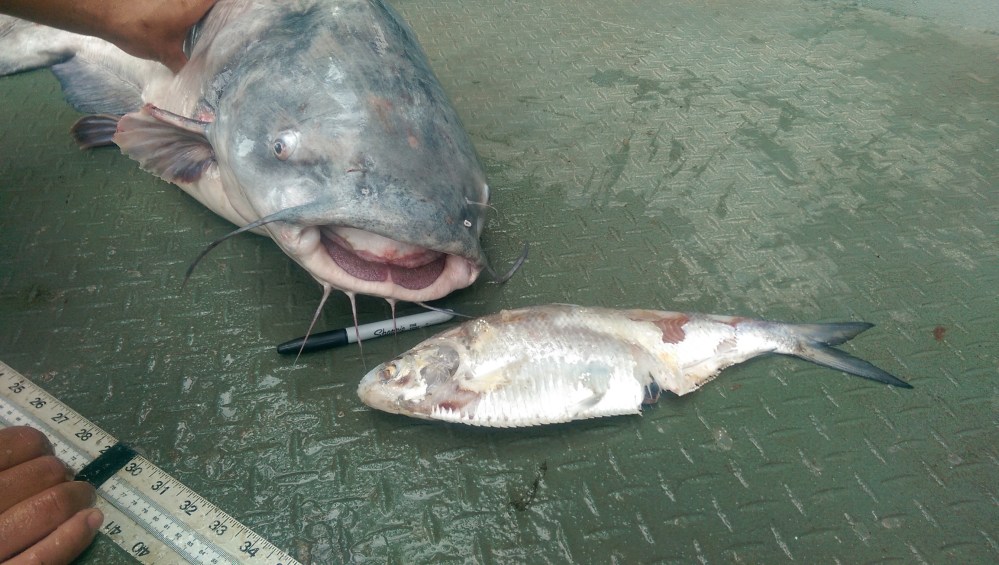What do fish eat?
With regard to the non-native Blue Catfish in Virginia’s tidal rivers, this question is routinely answered as “everything!” Once these Blue Catfish grow over 23 inches, however, they shift to piscivorous (eating mostly fish) diets that allow them to grow to weights in excess of 100 pounds! These fishy diets wouldn’t be a problem in their native range, but the tidal rivers of Virginia are home to American shad, Alewife, and Blueback herring all species of conservation concern.

Fisheries Scientists are now concerned about the potential for Blue Catfish to hamper the recovery of these anadromous species. To understand these predatory effects, researchers at Virginia Tech have been studying the diets of Blue Catfish, with support from the Virginia Department of Game and Inland Fisheries (VDGIF) and the Sportfish Restoration Act.
The project’s goals are fairly straightforward. Blue Catfish are captured and stomach samples collected using pulsed gastric lavage (PGL). Blue Catfish stomach items are brought back to the lab and identified using dichotomous keys.
Pulsed gastric lavage removes stomach contents without harming the fish.
One major snag in this project arises when trying to identify partially digested unidentifiable fish (PDUF). With little to no distinguishing characteristics in PDUF, biologists are often left scratching their heads about how to identify these fish prey.

But now a new tool is emerging that can help us to identify these important missing pieces of information. In 2003, Paul Heger (edit: Hebert) and his associates proposed a simple identification technique that works just like how a scanner at the supermarket reads the labels on your food. This technique is called DNA Barcoding. DNA barcoding works by sequencing the mitochondrial gene called cytochrome oxidase I (COI) and comparing it to entries in the Barcode of Life (BOL) database. Birds, reptiles, amphibians, mammals, and fish can be “barcoded” by comparing their COI region to this online database using the Basic Local Alignment Search Tool (BLAST).
So how do we solve the mystery of the unidentified fish prey using DNA barcoding?
Incredibly, enough intact DNA can be extracted from the fish prey of these Blue Catfish. DNA is extracted and amplified using a cocktail of universal fish primers for PCR. After Senger sequencing, these samples are compared to the BOL database for identification!
So can the mystery of the unidentified fish prey be solved?

The answer is yes! We were able to identify 80 % of samples that would have otherwise been classified as “unidentified”. Compared to identifying fish prey by conventional methods such as otolith shape and vertebrae structure, DNA barcoding provides a much faster and effective method. Some really neat fish prey that were identified with DNA barcodes included Hogchoker, Blue Spotted Sunfish, Spot Croaker, Shorthead Redhorse, Inland Silverside, and Striped Bass!
Blue Catfish may be opportunistic feeders, but their fish prey diets are now no longer a mystery.
by Zach Moran, guest blogger

Reference for Heger et al 2003 please.
Please note that it was P. Hebert and not P. Heger; see the corrected mistake in the post. Here’s the reference:
Hebert, P.D. et al. 2003. Biological identifications through DNA barcodes. Proc. Royal Soc. B 282: 313-321.
Thank you!